Engineering Thesis: Accelerometer Signal Processing in Weightlifting
VerifiedAdded on 2023/06/11
|40
|11569
|83
Project
AI Summary
This document presents an engineering thesis plan focused on processing accelerometer signals to enhance weightlifting performance analysis. It begins with an introduction to accelerometers and their applications, followed by a literature review of existing weightlifting measurement techniques, including potentiometers, digital rotary encoders, motion capture systems, and the V-ScopeTM method. The study aims to validate the use of accelerometer sensors by comparing their measurements with those of other devices, hypothesizing a strong correlation between the data. The project outlines the methodology, including the use of MATLAB for signal processing and data analysis, and sets objectives to improve weightlifting performance, compare accelerometer performance with contemporary techniques, estimate velocity and displacement during weightlifting cycles, and evaluate insights gained from the analysis. The ultimate goal is to establish the feasibility and validity of using accelerometer signals for real-time training feedback.
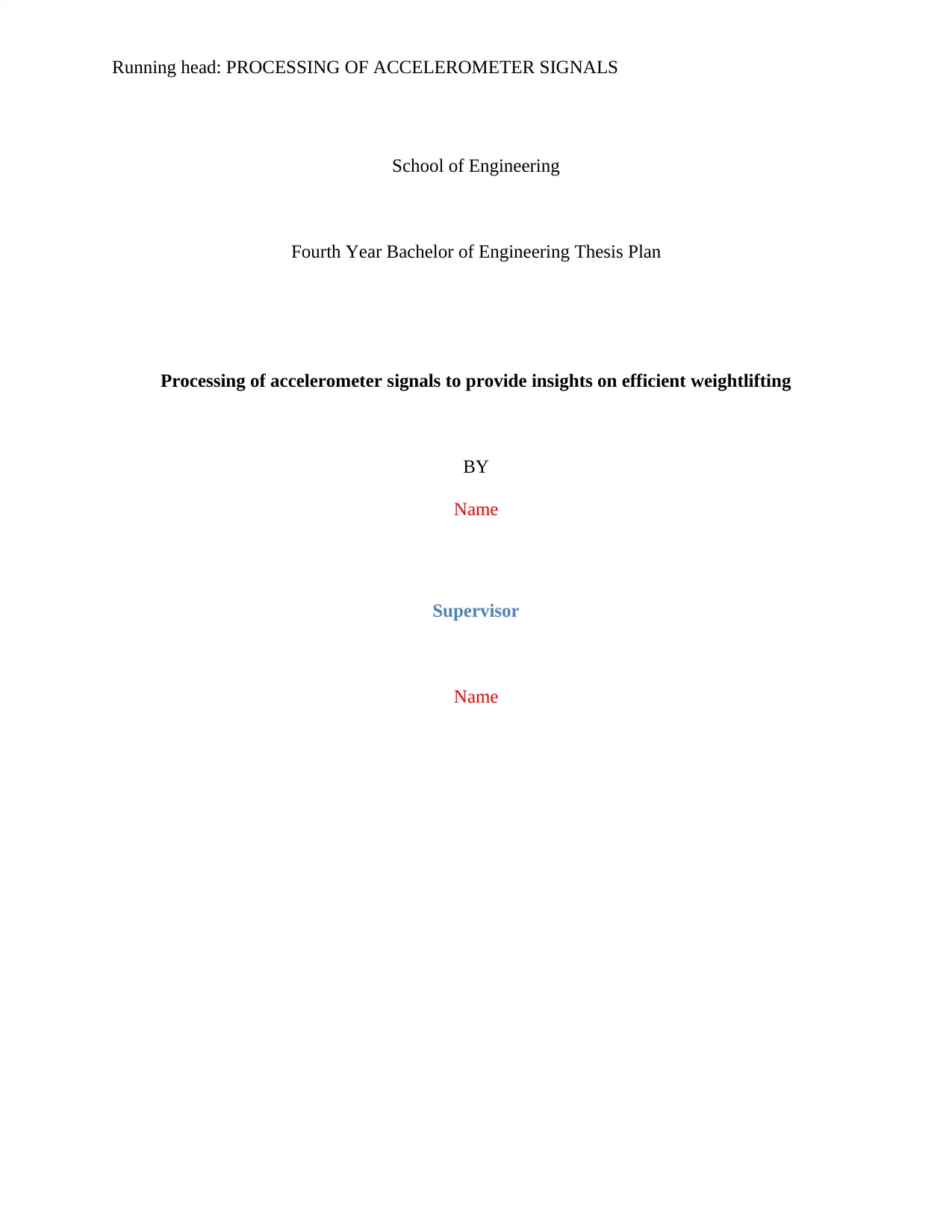
Running head: PROCESSING OF ACCELEROMETER SIGNALS
School of Engineering
Fourth Year Bachelor of Engineering Thesis Plan
Processing of accelerometer signals to provide insights on efficient weightlifting
BY
Name
Supervisor
Name
School of Engineering
Fourth Year Bachelor of Engineering Thesis Plan
Processing of accelerometer signals to provide insights on efficient weightlifting
BY
Name
Supervisor
Name
Paraphrase This Document
Need a fresh take? Get an instant paraphrase of this document with our AI Paraphraser
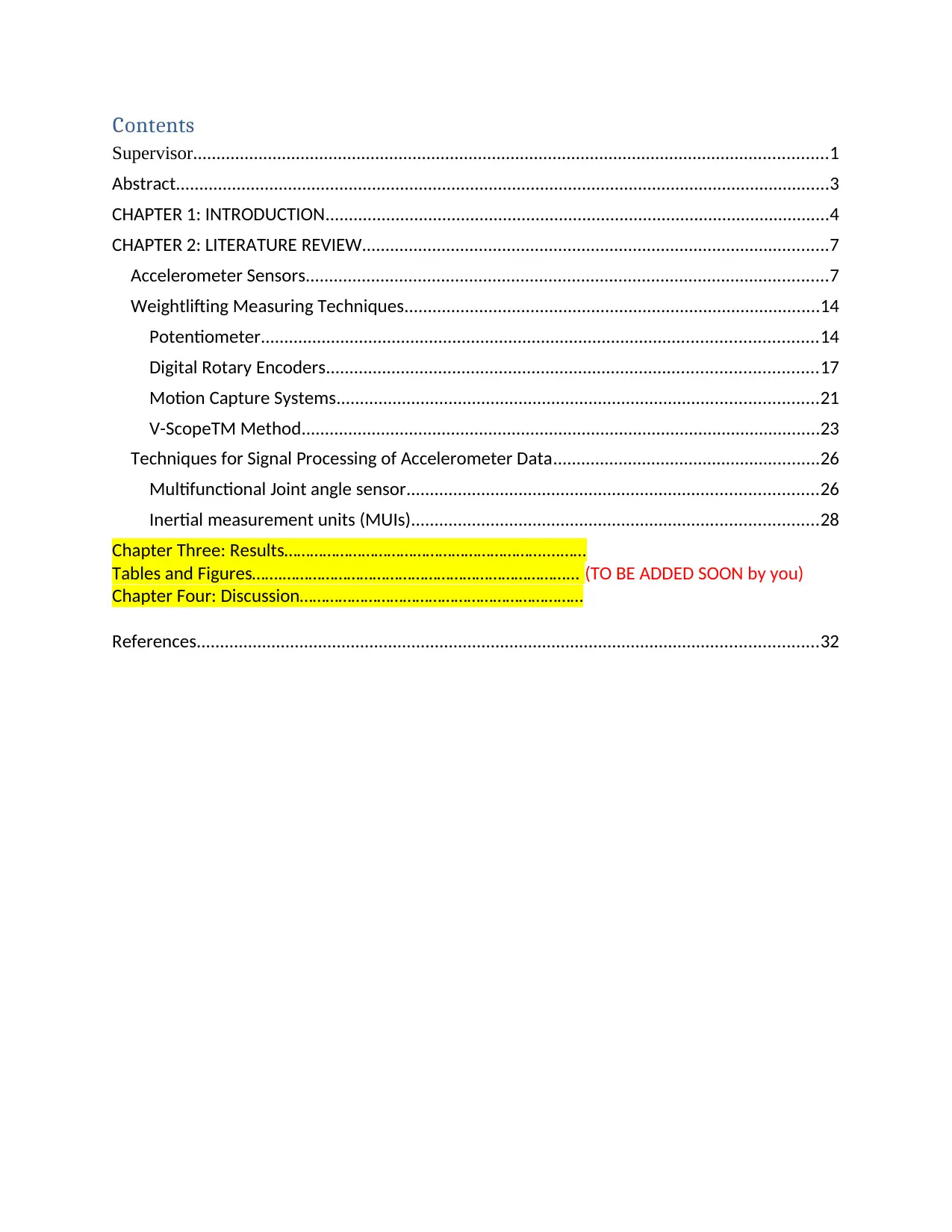
Contents
Supervisor........................................................................................................................................1
Abstract............................................................................................................................................3
CHAPTER 1: INTRODUCTION............................................................................................................4
CHAPTER 2: LITERATURE REVIEW....................................................................................................7
Accelerometer Sensors................................................................................................................7
Weightlifting Measuring Techniques.........................................................................................14
Potentiometer.......................................................................................................................14
Digital Rotary Encoders.........................................................................................................17
Motion Capture Systems.......................................................................................................21
V-ScopeTM Method...............................................................................................................23
Techniques for Signal Processing of Accelerometer Data.........................................................26
Multifunctional Joint angle sensor........................................................................................26
Inertial measurement units (MUIs).......................................................................................28
Chapter Three: Results……………………………………………………....……
Tables and Figures…….…………………………………………………………... (TO BE ADDED SOON by you)
Chapter Four: Discussion…………………………………………………………
References.....................................................................................................................................32
Supervisor........................................................................................................................................1
Abstract............................................................................................................................................3
CHAPTER 1: INTRODUCTION............................................................................................................4
CHAPTER 2: LITERATURE REVIEW....................................................................................................7
Accelerometer Sensors................................................................................................................7
Weightlifting Measuring Techniques.........................................................................................14
Potentiometer.......................................................................................................................14
Digital Rotary Encoders.........................................................................................................17
Motion Capture Systems.......................................................................................................21
V-ScopeTM Method...............................................................................................................23
Techniques for Signal Processing of Accelerometer Data.........................................................26
Multifunctional Joint angle sensor........................................................................................26
Inertial measurement units (MUIs).......................................................................................28
Chapter Three: Results……………………………………………………....……
Tables and Figures…….…………………………………………………………... (TO BE ADDED SOON by you)
Chapter Four: Discussion…………………………………………………………
References.....................................................................................................................................32
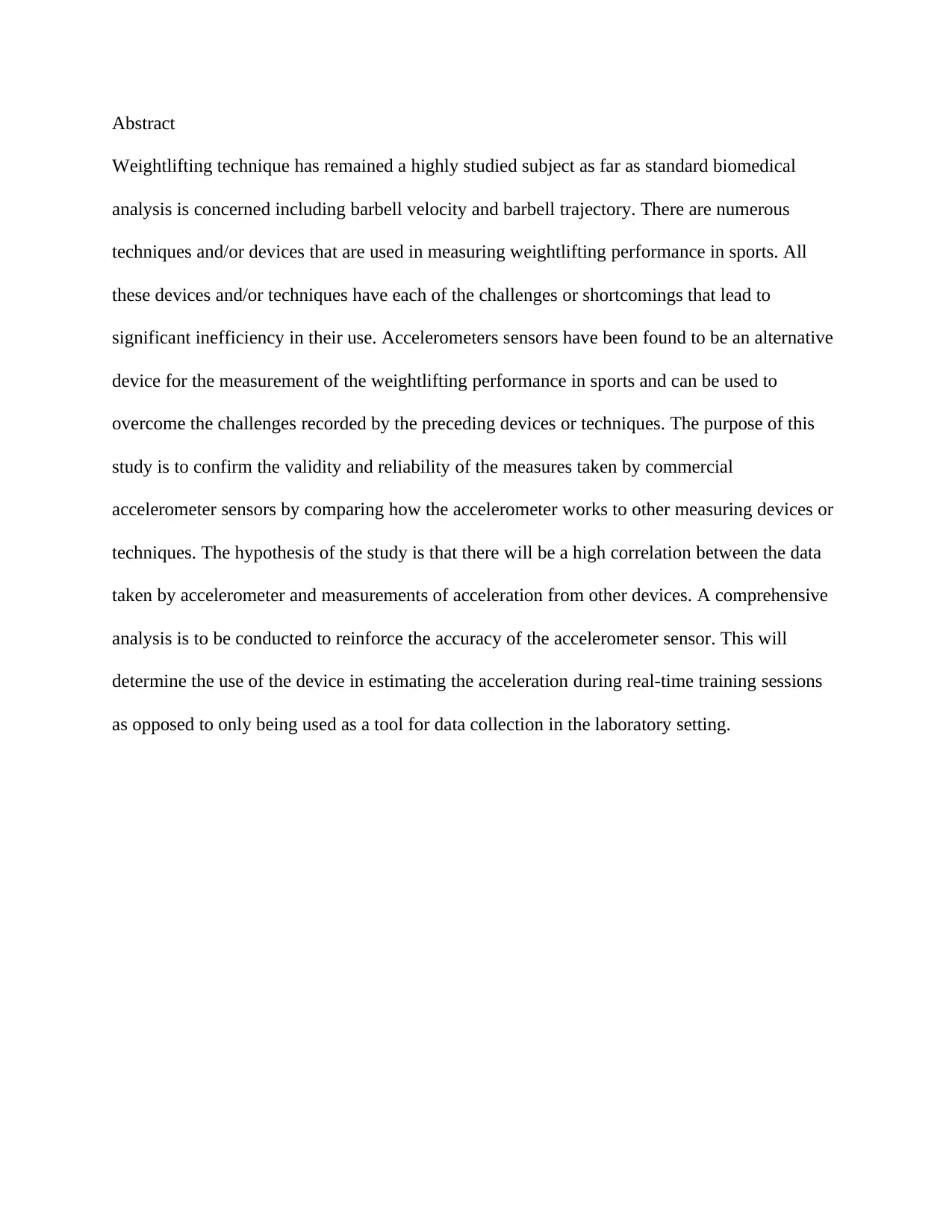
Abstract
Weightlifting technique has remained a highly studied subject as far as standard biomedical
analysis is concerned including barbell velocity and barbell trajectory. There are numerous
techniques and/or devices that are used in measuring weightlifting performance in sports. All
these devices and/or techniques have each of the challenges or shortcomings that lead to
significant inefficiency in their use. Accelerometers sensors have been found to be an alternative
device for the measurement of the weightlifting performance in sports and can be used to
overcome the challenges recorded by the preceding devices or techniques. The purpose of this
study is to confirm the validity and reliability of the measures taken by commercial
accelerometer sensors by comparing how the accelerometer works to other measuring devices or
techniques. The hypothesis of the study is that there will be a high correlation between the data
taken by accelerometer and measurements of acceleration from other devices. A comprehensive
analysis is to be conducted to reinforce the accuracy of the accelerometer sensor. This will
determine the use of the device in estimating the acceleration during real-time training sessions
as opposed to only being used as a tool for data collection in the laboratory setting.
Weightlifting technique has remained a highly studied subject as far as standard biomedical
analysis is concerned including barbell velocity and barbell trajectory. There are numerous
techniques and/or devices that are used in measuring weightlifting performance in sports. All
these devices and/or techniques have each of the challenges or shortcomings that lead to
significant inefficiency in their use. Accelerometers sensors have been found to be an alternative
device for the measurement of the weightlifting performance in sports and can be used to
overcome the challenges recorded by the preceding devices or techniques. The purpose of this
study is to confirm the validity and reliability of the measures taken by commercial
accelerometer sensors by comparing how the accelerometer works to other measuring devices or
techniques. The hypothesis of the study is that there will be a high correlation between the data
taken by accelerometer and measurements of acceleration from other devices. A comprehensive
analysis is to be conducted to reinforce the accuracy of the accelerometer sensor. This will
determine the use of the device in estimating the acceleration during real-time training sessions
as opposed to only being used as a tool for data collection in the laboratory setting.
⊘ This is a preview!⊘
Do you want full access?
Subscribe today to unlock all pages.

Trusted by 1+ million students worldwide
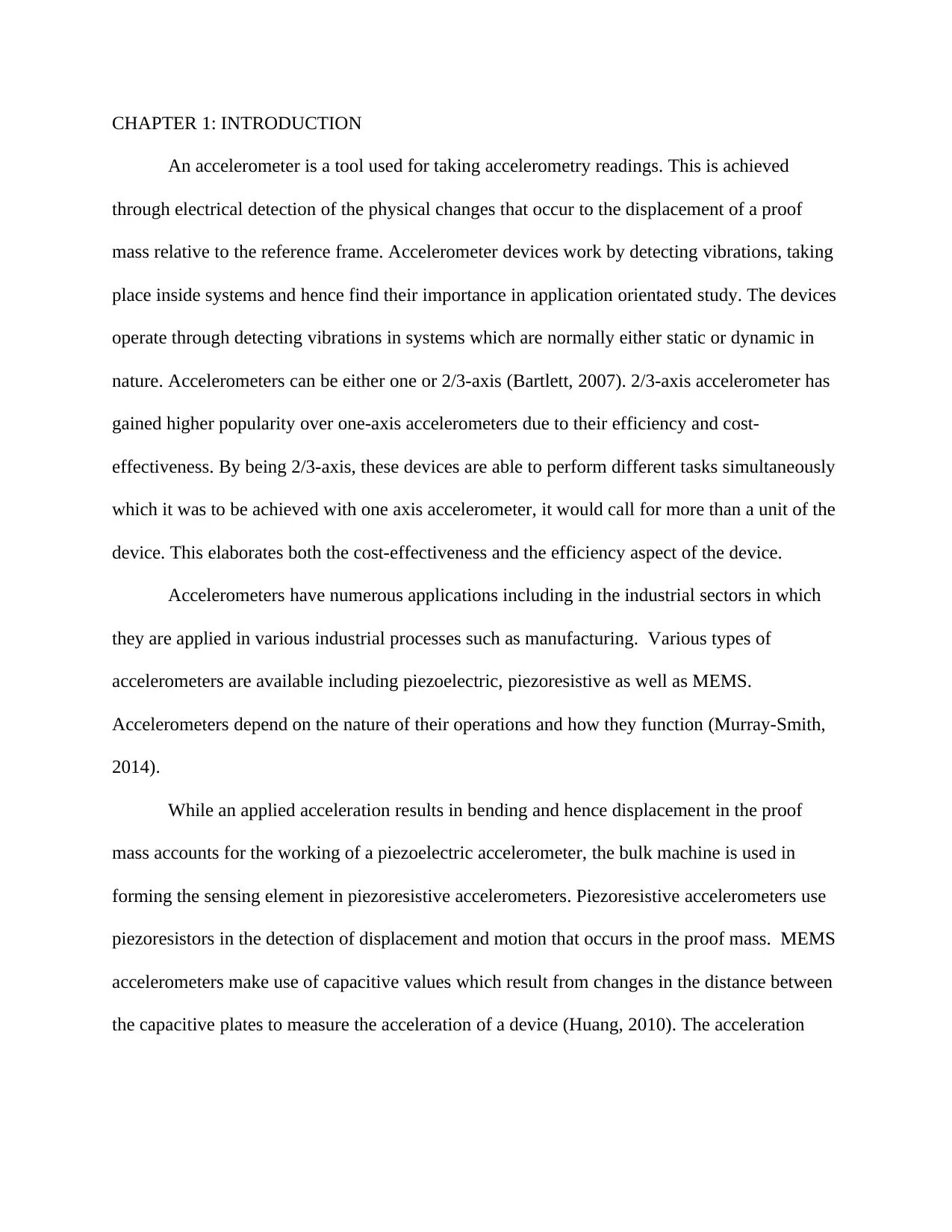
CHAPTER 1: INTRODUCTION
An accelerometer is a tool used for taking accelerometry readings. This is achieved
through electrical detection of the physical changes that occur to the displacement of a proof
mass relative to the reference frame. Accelerometer devices work by detecting vibrations, taking
place inside systems and hence find their importance in application orientated study. The devices
operate through detecting vibrations in systems which are normally either static or dynamic in
nature. Accelerometers can be either one or 2/3-axis (Bartlett, 2007). 2/3-axis accelerometer has
gained higher popularity over one-axis accelerometers due to their efficiency and cost-
effectiveness. By being 2/3-axis, these devices are able to perform different tasks simultaneously
which it was to be achieved with one axis accelerometer, it would call for more than a unit of the
device. This elaborates both the cost-effectiveness and the efficiency aspect of the device.
Accelerometers have numerous applications including in the industrial sectors in which
they are applied in various industrial processes such as manufacturing. Various types of
accelerometers are available including piezoelectric, piezoresistive as well as MEMS.
Accelerometers depend on the nature of their operations and how they function (Murray-Smith,
2014).
While an applied acceleration results in bending and hence displacement in the proof
mass accounts for the working of a piezoelectric accelerometer, the bulk machine is used in
forming the sensing element in piezoresistive accelerometers. Piezoresistive accelerometers use
piezoresistors in the detection of displacement and motion that occurs in the proof mass. MEMS
accelerometers make use of capacitive values which result from changes in the distance between
the capacitive plates to measure the acceleration of a device (Huang, 2010). The acceleration
An accelerometer is a tool used for taking accelerometry readings. This is achieved
through electrical detection of the physical changes that occur to the displacement of a proof
mass relative to the reference frame. Accelerometer devices work by detecting vibrations, taking
place inside systems and hence find their importance in application orientated study. The devices
operate through detecting vibrations in systems which are normally either static or dynamic in
nature. Accelerometers can be either one or 2/3-axis (Bartlett, 2007). 2/3-axis accelerometer has
gained higher popularity over one-axis accelerometers due to their efficiency and cost-
effectiveness. By being 2/3-axis, these devices are able to perform different tasks simultaneously
which it was to be achieved with one axis accelerometer, it would call for more than a unit of the
device. This elaborates both the cost-effectiveness and the efficiency aspect of the device.
Accelerometers have numerous applications including in the industrial sectors in which
they are applied in various industrial processes such as manufacturing. Various types of
accelerometers are available including piezoelectric, piezoresistive as well as MEMS.
Accelerometers depend on the nature of their operations and how they function (Murray-Smith,
2014).
While an applied acceleration results in bending and hence displacement in the proof
mass accounts for the working of a piezoelectric accelerometer, the bulk machine is used in
forming the sensing element in piezoresistive accelerometers. Piezoresistive accelerometers use
piezoresistors in the detection of displacement and motion that occurs in the proof mass. MEMS
accelerometers make use of capacitive values which result from changes in the distance between
the capacitive plates to measure the acceleration of a device (Huang, 2010). The acceleration
Paraphrase This Document
Need a fresh take? Get an instant paraphrase of this document with our AI Paraphraser
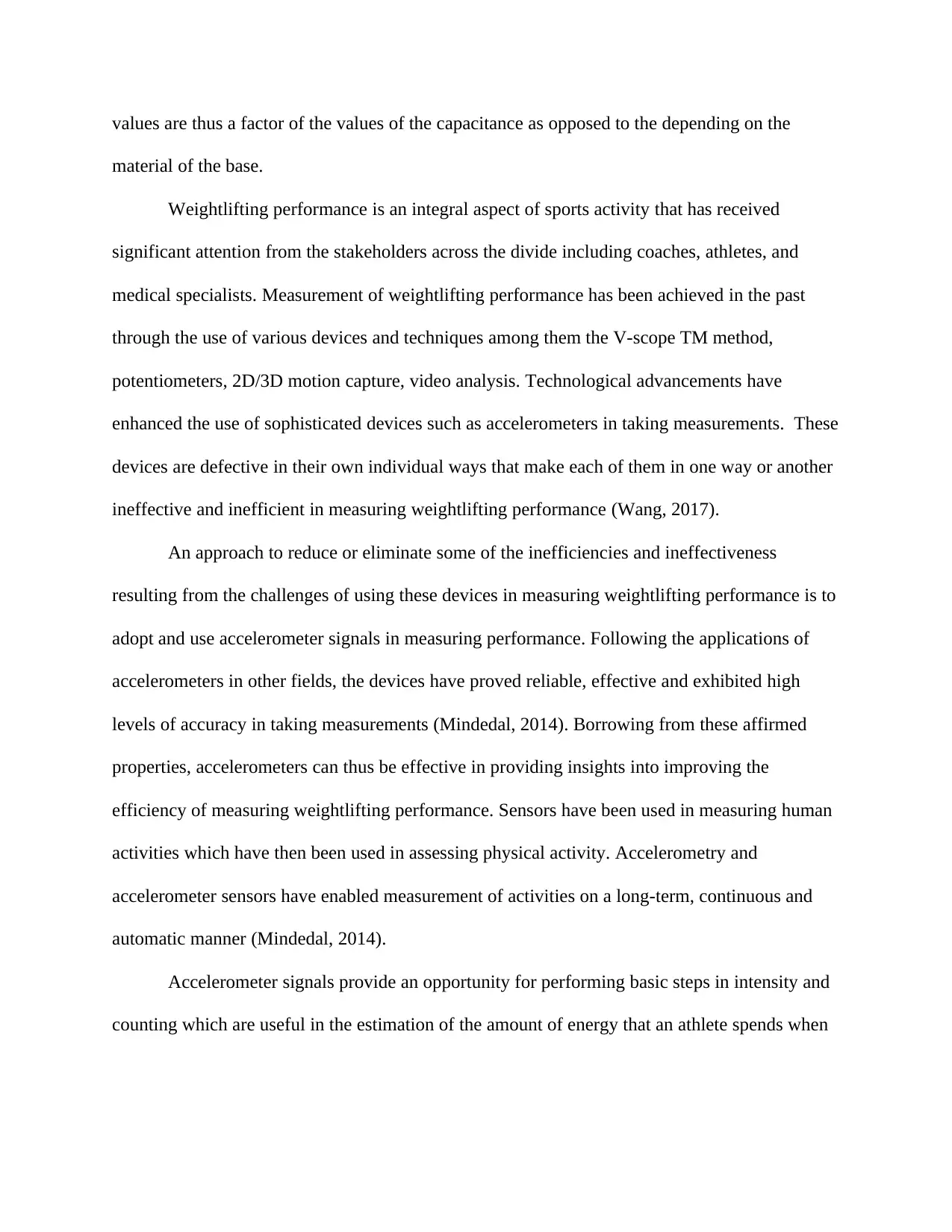
values are thus a factor of the values of the capacitance as opposed to the depending on the
material of the base.
Weightlifting performance is an integral aspect of sports activity that has received
significant attention from the stakeholders across the divide including coaches, athletes, and
medical specialists. Measurement of weightlifting performance has been achieved in the past
through the use of various devices and techniques among them the V-scope TM method,
potentiometers, 2D/3D motion capture, video analysis. Technological advancements have
enhanced the use of sophisticated devices such as accelerometers in taking measurements. These
devices are defective in their own individual ways that make each of them in one way or another
ineffective and inefficient in measuring weightlifting performance (Wang, 2017).
An approach to reduce or eliminate some of the inefficiencies and ineffectiveness
resulting from the challenges of using these devices in measuring weightlifting performance is to
adopt and use accelerometer signals in measuring performance. Following the applications of
accelerometers in other fields, the devices have proved reliable, effective and exhibited high
levels of accuracy in taking measurements (Mindedal, 2014). Borrowing from these affirmed
properties, accelerometers can thus be effective in providing insights into improving the
efficiency of measuring weightlifting performance. Sensors have been used in measuring human
activities which have then been used in assessing physical activity. Accelerometry and
accelerometer sensors have enabled measurement of activities on a long-term, continuous and
automatic manner (Mindedal, 2014).
Accelerometer signals provide an opportunity for performing basic steps in intensity and
counting which are useful in the estimation of the amount of energy that an athlete spends when
material of the base.
Weightlifting performance is an integral aspect of sports activity that has received
significant attention from the stakeholders across the divide including coaches, athletes, and
medical specialists. Measurement of weightlifting performance has been achieved in the past
through the use of various devices and techniques among them the V-scope TM method,
potentiometers, 2D/3D motion capture, video analysis. Technological advancements have
enhanced the use of sophisticated devices such as accelerometers in taking measurements. These
devices are defective in their own individual ways that make each of them in one way or another
ineffective and inefficient in measuring weightlifting performance (Wang, 2017).
An approach to reduce or eliminate some of the inefficiencies and ineffectiveness
resulting from the challenges of using these devices in measuring weightlifting performance is to
adopt and use accelerometer signals in measuring performance. Following the applications of
accelerometers in other fields, the devices have proved reliable, effective and exhibited high
levels of accuracy in taking measurements (Mindedal, 2014). Borrowing from these affirmed
properties, accelerometers can thus be effective in providing insights into improving the
efficiency of measuring weightlifting performance. Sensors have been used in measuring human
activities which have then been used in assessing physical activity. Accelerometry and
accelerometer sensors have enabled measurement of activities on a long-term, continuous and
automatic manner (Mindedal, 2014).
Accelerometer signals provide an opportunity for performing basic steps in intensity and
counting which are useful in the estimation of the amount of energy that an athlete spends when
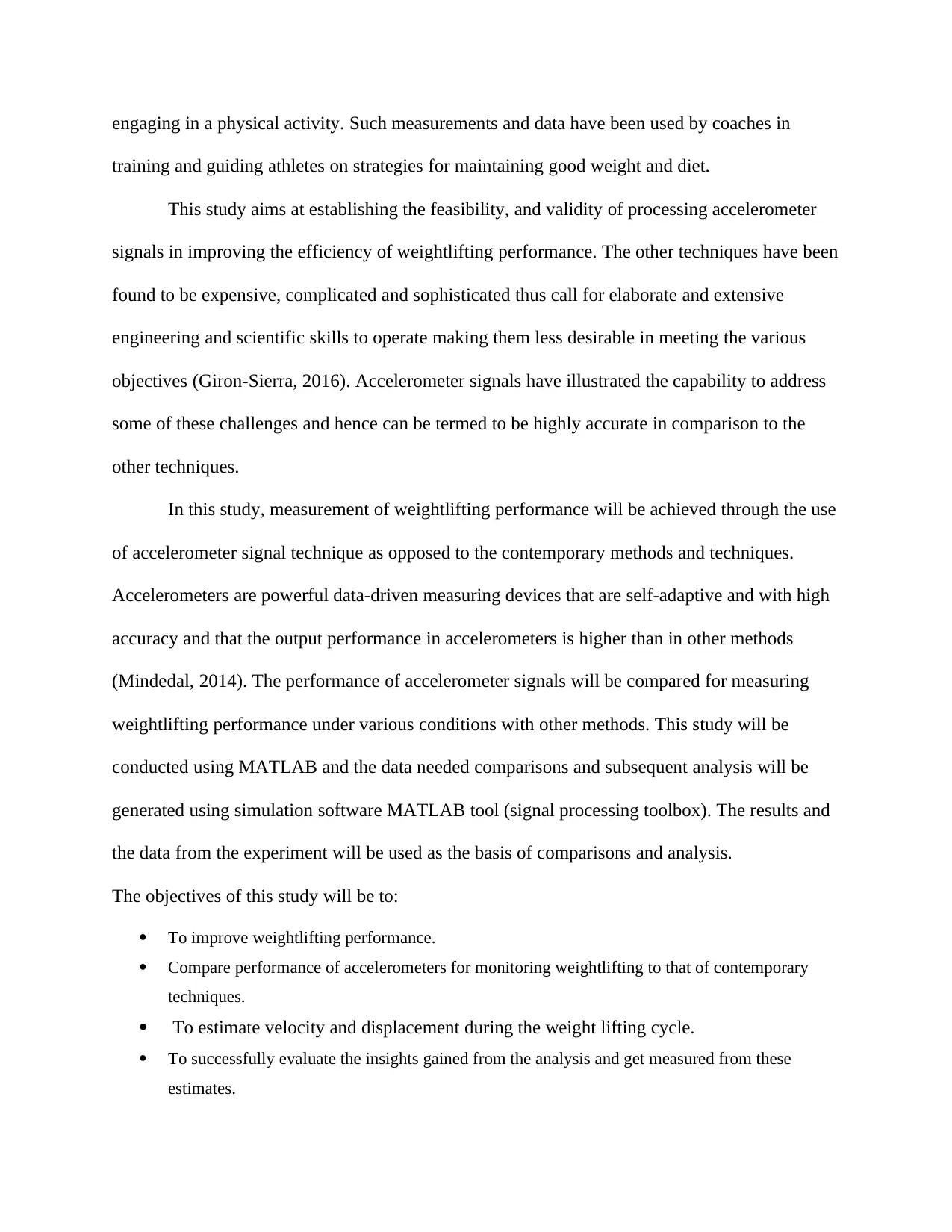
engaging in a physical activity. Such measurements and data have been used by coaches in
training and guiding athletes on strategies for maintaining good weight and diet.
This study aims at establishing the feasibility, and validity of processing accelerometer
signals in improving the efficiency of weightlifting performance. The other techniques have been
found to be expensive, complicated and sophisticated thus call for elaborate and extensive
engineering and scientific skills to operate making them less desirable in meeting the various
objectives (Giron-Sierra, 2016). Accelerometer signals have illustrated the capability to address
some of these challenges and hence can be termed to be highly accurate in comparison to the
other techniques.
In this study, measurement of weightlifting performance will be achieved through the use
of accelerometer signal technique as opposed to the contemporary methods and techniques.
Accelerometers are powerful data-driven measuring devices that are self-adaptive and with high
accuracy and that the output performance in accelerometers is higher than in other methods
(Mindedal, 2014). The performance of accelerometer signals will be compared for measuring
weightlifting performance under various conditions with other methods. This study will be
conducted using MATLAB and the data needed comparisons and subsequent analysis will be
generated using simulation software MATLAB tool (signal processing toolbox). The results and
the data from the experiment will be used as the basis of comparisons and analysis.
The objectives of this study will be to:
To improve weightlifting performance.
Compare performance of accelerometers for monitoring weightlifting to that of contemporary
techniques.
To estimate velocity and displacement during the weight lifting cycle.
To successfully evaluate the insights gained from the analysis and get measured from these
estimates.
training and guiding athletes on strategies for maintaining good weight and diet.
This study aims at establishing the feasibility, and validity of processing accelerometer
signals in improving the efficiency of weightlifting performance. The other techniques have been
found to be expensive, complicated and sophisticated thus call for elaborate and extensive
engineering and scientific skills to operate making them less desirable in meeting the various
objectives (Giron-Sierra, 2016). Accelerometer signals have illustrated the capability to address
some of these challenges and hence can be termed to be highly accurate in comparison to the
other techniques.
In this study, measurement of weightlifting performance will be achieved through the use
of accelerometer signal technique as opposed to the contemporary methods and techniques.
Accelerometers are powerful data-driven measuring devices that are self-adaptive and with high
accuracy and that the output performance in accelerometers is higher than in other methods
(Mindedal, 2014). The performance of accelerometer signals will be compared for measuring
weightlifting performance under various conditions with other methods. This study will be
conducted using MATLAB and the data needed comparisons and subsequent analysis will be
generated using simulation software MATLAB tool (signal processing toolbox). The results and
the data from the experiment will be used as the basis of comparisons and analysis.
The objectives of this study will be to:
To improve weightlifting performance.
Compare performance of accelerometers for monitoring weightlifting to that of contemporary
techniques.
To estimate velocity and displacement during the weight lifting cycle.
To successfully evaluate the insights gained from the analysis and get measured from these
estimates.
⊘ This is a preview!⊘
Do you want full access?
Subscribe today to unlock all pages.

Trusted by 1+ million students worldwide
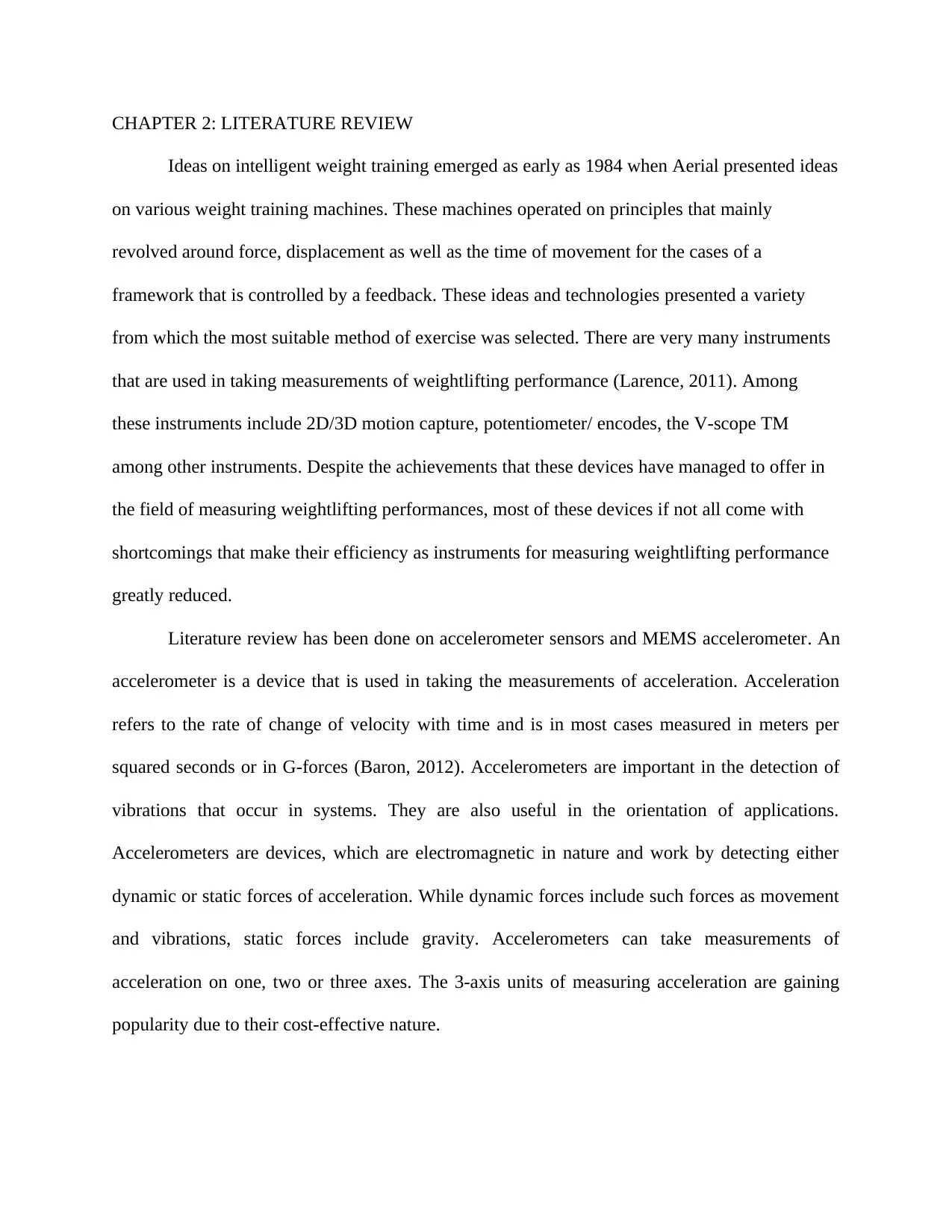
CHAPTER 2: LITERATURE REVIEW
Ideas on intelligent weight training emerged as early as 1984 when Aerial presented ideas
on various weight training machines. These machines operated on principles that mainly
revolved around force, displacement as well as the time of movement for the cases of a
framework that is controlled by a feedback. These ideas and technologies presented a variety
from which the most suitable method of exercise was selected. There are very many instruments
that are used in taking measurements of weightlifting performance (Larence, 2011). Among
these instruments include 2D/3D motion capture, potentiometer/ encodes, the V-scope TM
among other instruments. Despite the achievements that these devices have managed to offer in
the field of measuring weightlifting performances, most of these devices if not all come with
shortcomings that make their efficiency as instruments for measuring weightlifting performance
greatly reduced.
Literature review has been done on accelerometer sensors and MEMS accelerometer. An
accelerometer is a device that is used in taking the measurements of acceleration. Acceleration
refers to the rate of change of velocity with time and is in most cases measured in meters per
squared seconds or in G-forces (Baron, 2012). Accelerometers are important in the detection of
vibrations that occur in systems. They are also useful in the orientation of applications.
Accelerometers are devices, which are electromagnetic in nature and work by detecting either
dynamic or static forces of acceleration. While dynamic forces include such forces as movement
and vibrations, static forces include gravity. Accelerometers can take measurements of
acceleration on one, two or three axes. The 3-axis units of measuring acceleration are gaining
popularity due to their cost-effective nature.
Ideas on intelligent weight training emerged as early as 1984 when Aerial presented ideas
on various weight training machines. These machines operated on principles that mainly
revolved around force, displacement as well as the time of movement for the cases of a
framework that is controlled by a feedback. These ideas and technologies presented a variety
from which the most suitable method of exercise was selected. There are very many instruments
that are used in taking measurements of weightlifting performance (Larence, 2011). Among
these instruments include 2D/3D motion capture, potentiometer/ encodes, the V-scope TM
among other instruments. Despite the achievements that these devices have managed to offer in
the field of measuring weightlifting performances, most of these devices if not all come with
shortcomings that make their efficiency as instruments for measuring weightlifting performance
greatly reduced.
Literature review has been done on accelerometer sensors and MEMS accelerometer. An
accelerometer is a device that is used in taking the measurements of acceleration. Acceleration
refers to the rate of change of velocity with time and is in most cases measured in meters per
squared seconds or in G-forces (Baron, 2012). Accelerometers are important in the detection of
vibrations that occur in systems. They are also useful in the orientation of applications.
Accelerometers are devices, which are electromagnetic in nature and work by detecting either
dynamic or static forces of acceleration. While dynamic forces include such forces as movement
and vibrations, static forces include gravity. Accelerometers can take measurements of
acceleration on one, two or three axes. The 3-axis units of measuring acceleration are gaining
popularity due to their cost-effective nature.
Paraphrase This Document
Need a fresh take? Get an instant paraphrase of this document with our AI Paraphraser
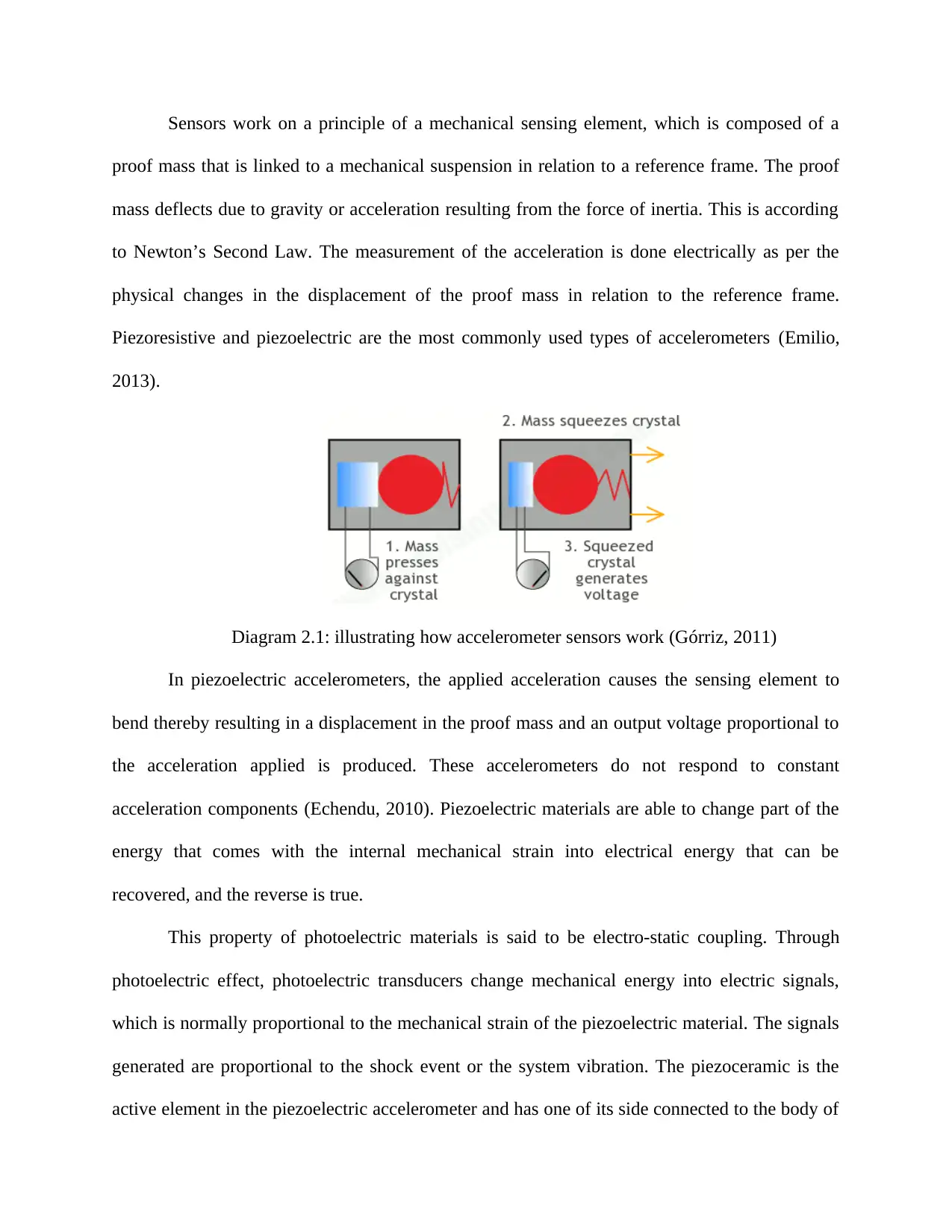
Sensors work on a principle of a mechanical sensing element, which is composed of a
proof mass that is linked to a mechanical suspension in relation to a reference frame. The proof
mass deflects due to gravity or acceleration resulting from the force of inertia. This is according
to Newton’s Second Law. The measurement of the acceleration is done electrically as per the
physical changes in the displacement of the proof mass in relation to the reference frame.
Piezoresistive and piezoelectric are the most commonly used types of accelerometers (Emilio,
2013).
Diagram 2.1: illustrating how accelerometer sensors work (Górriz, 2011)
In piezoelectric accelerometers, the applied acceleration causes the sensing element to
bend thereby resulting in a displacement in the proof mass and an output voltage proportional to
the acceleration applied is produced. These accelerometers do not respond to constant
acceleration components (Echendu, 2010). Piezoelectric materials are able to change part of the
energy that comes with the internal mechanical strain into electrical energy that can be
recovered, and the reverse is true.
This property of photoelectric materials is said to be electro-static coupling. Through
photoelectric effect, photoelectric transducers change mechanical energy into electric signals,
which is normally proportional to the mechanical strain of the piezoelectric material. The signals
generated are proportional to the shock event or the system vibration. The piezoceramic is the
active element in the piezoelectric accelerometer and has one of its side connected to the body of
proof mass that is linked to a mechanical suspension in relation to a reference frame. The proof
mass deflects due to gravity or acceleration resulting from the force of inertia. This is according
to Newton’s Second Law. The measurement of the acceleration is done electrically as per the
physical changes in the displacement of the proof mass in relation to the reference frame.
Piezoresistive and piezoelectric are the most commonly used types of accelerometers (Emilio,
2013).
Diagram 2.1: illustrating how accelerometer sensors work (Górriz, 2011)
In piezoelectric accelerometers, the applied acceleration causes the sensing element to
bend thereby resulting in a displacement in the proof mass and an output voltage proportional to
the acceleration applied is produced. These accelerometers do not respond to constant
acceleration components (Echendu, 2010). Piezoelectric materials are able to change part of the
energy that comes with the internal mechanical strain into electrical energy that can be
recovered, and the reverse is true.
This property of photoelectric materials is said to be electro-static coupling. Through
photoelectric effect, photoelectric transducers change mechanical energy into electric signals,
which is normally proportional to the mechanical strain of the piezoelectric material. The signals
generated are proportional to the shock event or the system vibration. The piezoceramic is the
active element in the piezoelectric accelerometer and has one of its side connected to the body of
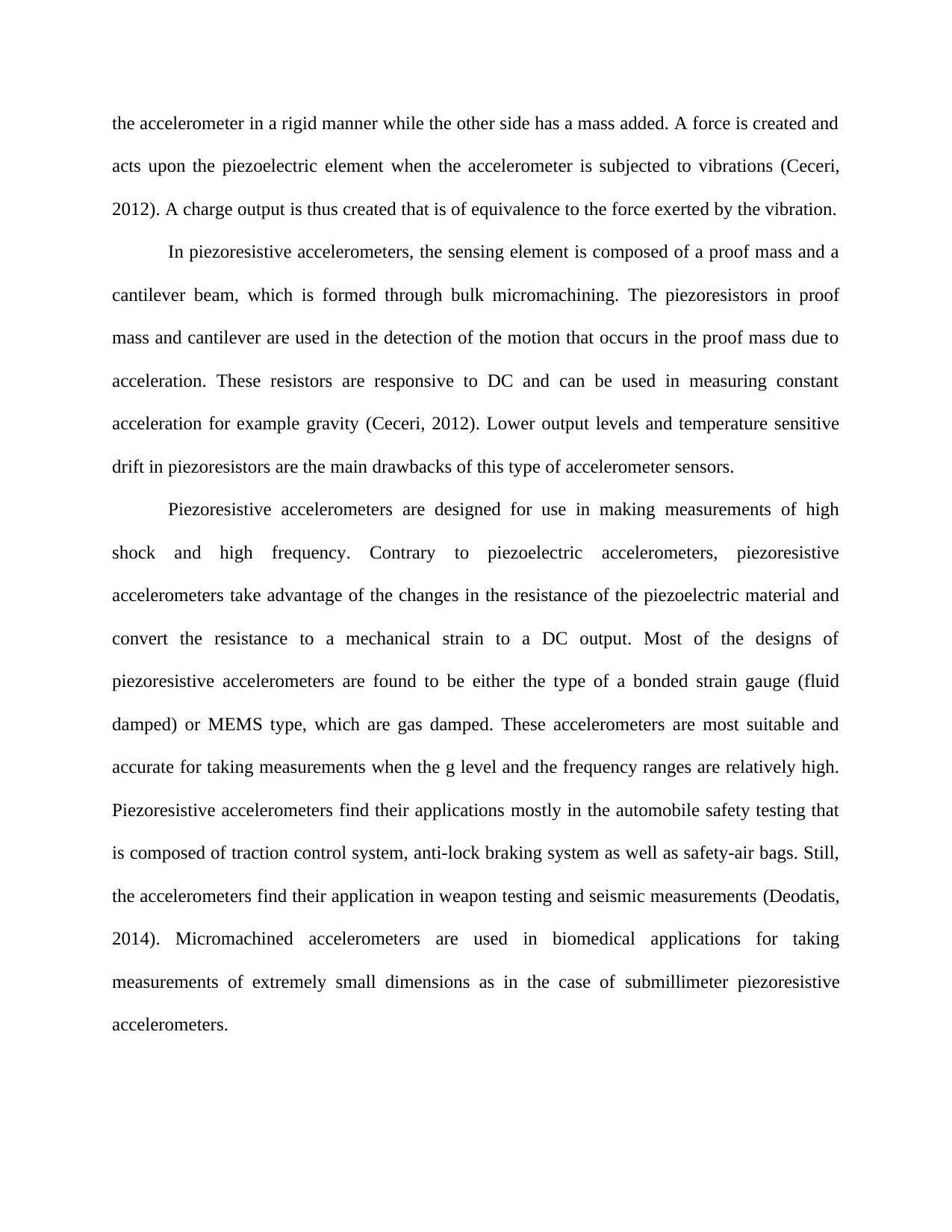
the accelerometer in a rigid manner while the other side has a mass added. A force is created and
acts upon the piezoelectric element when the accelerometer is subjected to vibrations (Ceceri,
2012). A charge output is thus created that is of equivalence to the force exerted by the vibration.
In piezoresistive accelerometers, the sensing element is composed of a proof mass and a
cantilever beam, which is formed through bulk micromachining. The piezoresistors in proof
mass and cantilever are used in the detection of the motion that occurs in the proof mass due to
acceleration. These resistors are responsive to DC and can be used in measuring constant
acceleration for example gravity (Ceceri, 2012). Lower output levels and temperature sensitive
drift in piezoresistors are the main drawbacks of this type of accelerometer sensors.
Piezoresistive accelerometers are designed for use in making measurements of high
shock and high frequency. Contrary to piezoelectric accelerometers, piezoresistive
accelerometers take advantage of the changes in the resistance of the piezoelectric material and
convert the resistance to a mechanical strain to a DC output. Most of the designs of
piezoresistive accelerometers are found to be either the type of a bonded strain gauge (fluid
damped) or MEMS type, which are gas damped. These accelerometers are most suitable and
accurate for taking measurements when the g level and the frequency ranges are relatively high.
Piezoresistive accelerometers find their applications mostly in the automobile safety testing that
is composed of traction control system, anti-lock braking system as well as safety-air bags. Still,
the accelerometers find their application in weapon testing and seismic measurements (Deodatis,
2014). Micromachined accelerometers are used in biomedical applications for taking
measurements of extremely small dimensions as in the case of submillimeter piezoresistive
accelerometers.
acts upon the piezoelectric element when the accelerometer is subjected to vibrations (Ceceri,
2012). A charge output is thus created that is of equivalence to the force exerted by the vibration.
In piezoresistive accelerometers, the sensing element is composed of a proof mass and a
cantilever beam, which is formed through bulk micromachining. The piezoresistors in proof
mass and cantilever are used in the detection of the motion that occurs in the proof mass due to
acceleration. These resistors are responsive to DC and can be used in measuring constant
acceleration for example gravity (Ceceri, 2012). Lower output levels and temperature sensitive
drift in piezoresistors are the main drawbacks of this type of accelerometer sensors.
Piezoresistive accelerometers are designed for use in making measurements of high
shock and high frequency. Contrary to piezoelectric accelerometers, piezoresistive
accelerometers take advantage of the changes in the resistance of the piezoelectric material and
convert the resistance to a mechanical strain to a DC output. Most of the designs of
piezoresistive accelerometers are found to be either the type of a bonded strain gauge (fluid
damped) or MEMS type, which are gas damped. These accelerometers are most suitable and
accurate for taking measurements when the g level and the frequency ranges are relatively high.
Piezoresistive accelerometers find their applications mostly in the automobile safety testing that
is composed of traction control system, anti-lock braking system as well as safety-air bags. Still,
the accelerometers find their application in weapon testing and seismic measurements (Deodatis,
2014). Micromachined accelerometers are used in biomedical applications for taking
measurements of extremely small dimensions as in the case of submillimeter piezoresistive
accelerometers.
⊘ This is a preview!⊘
Do you want full access?
Subscribe today to unlock all pages.

Trusted by 1+ million students worldwide
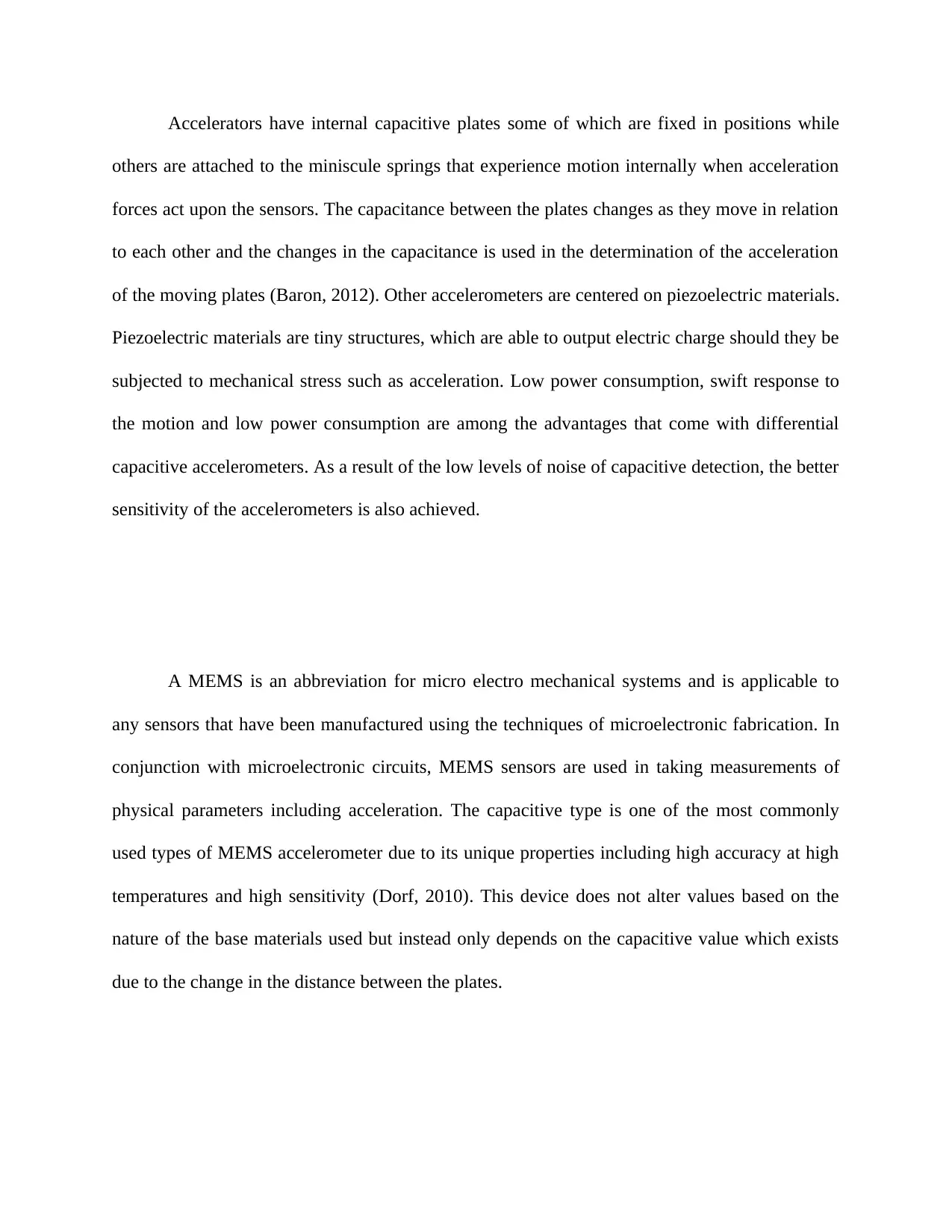
Accelerators have internal capacitive plates some of which are fixed in positions while
others are attached to the miniscule springs that experience motion internally when acceleration
forces act upon the sensors. The capacitance between the plates changes as they move in relation
to each other and the changes in the capacitance is used in the determination of the acceleration
of the moving plates (Baron, 2012). Other accelerometers are centered on piezoelectric materials.
Piezoelectric materials are tiny structures, which are able to output electric charge should they be
subjected to mechanical stress such as acceleration. Low power consumption, swift response to
the motion and low power consumption are among the advantages that come with differential
capacitive accelerometers. As a result of the low levels of noise of capacitive detection, the better
sensitivity of the accelerometers is also achieved.
A MEMS is an abbreviation for micro electro mechanical systems and is applicable to
any sensors that have been manufactured using the techniques of microelectronic fabrication. In
conjunction with microelectronic circuits, MEMS sensors are used in taking measurements of
physical parameters including acceleration. The capacitive type is one of the most commonly
used types of MEMS accelerometer due to its unique properties including high accuracy at high
temperatures and high sensitivity (Dorf, 2010). This device does not alter values based on the
nature of the base materials used but instead only depends on the capacitive value which exists
due to the change in the distance between the plates.
others are attached to the miniscule springs that experience motion internally when acceleration
forces act upon the sensors. The capacitance between the plates changes as they move in relation
to each other and the changes in the capacitance is used in the determination of the acceleration
of the moving plates (Baron, 2012). Other accelerometers are centered on piezoelectric materials.
Piezoelectric materials are tiny structures, which are able to output electric charge should they be
subjected to mechanical stress such as acceleration. Low power consumption, swift response to
the motion and low power consumption are among the advantages that come with differential
capacitive accelerometers. As a result of the low levels of noise of capacitive detection, the better
sensitivity of the accelerometers is also achieved.
A MEMS is an abbreviation for micro electro mechanical systems and is applicable to
any sensors that have been manufactured using the techniques of microelectronic fabrication. In
conjunction with microelectronic circuits, MEMS sensors are used in taking measurements of
physical parameters including acceleration. The capacitive type is one of the most commonly
used types of MEMS accelerometer due to its unique properties including high accuracy at high
temperatures and high sensitivity (Dorf, 2010). This device does not alter values based on the
nature of the base materials used but instead only depends on the capacitive value which exists
due to the change in the distance between the plates.
Paraphrase This Document
Need a fresh take? Get an instant paraphrase of this document with our AI Paraphraser
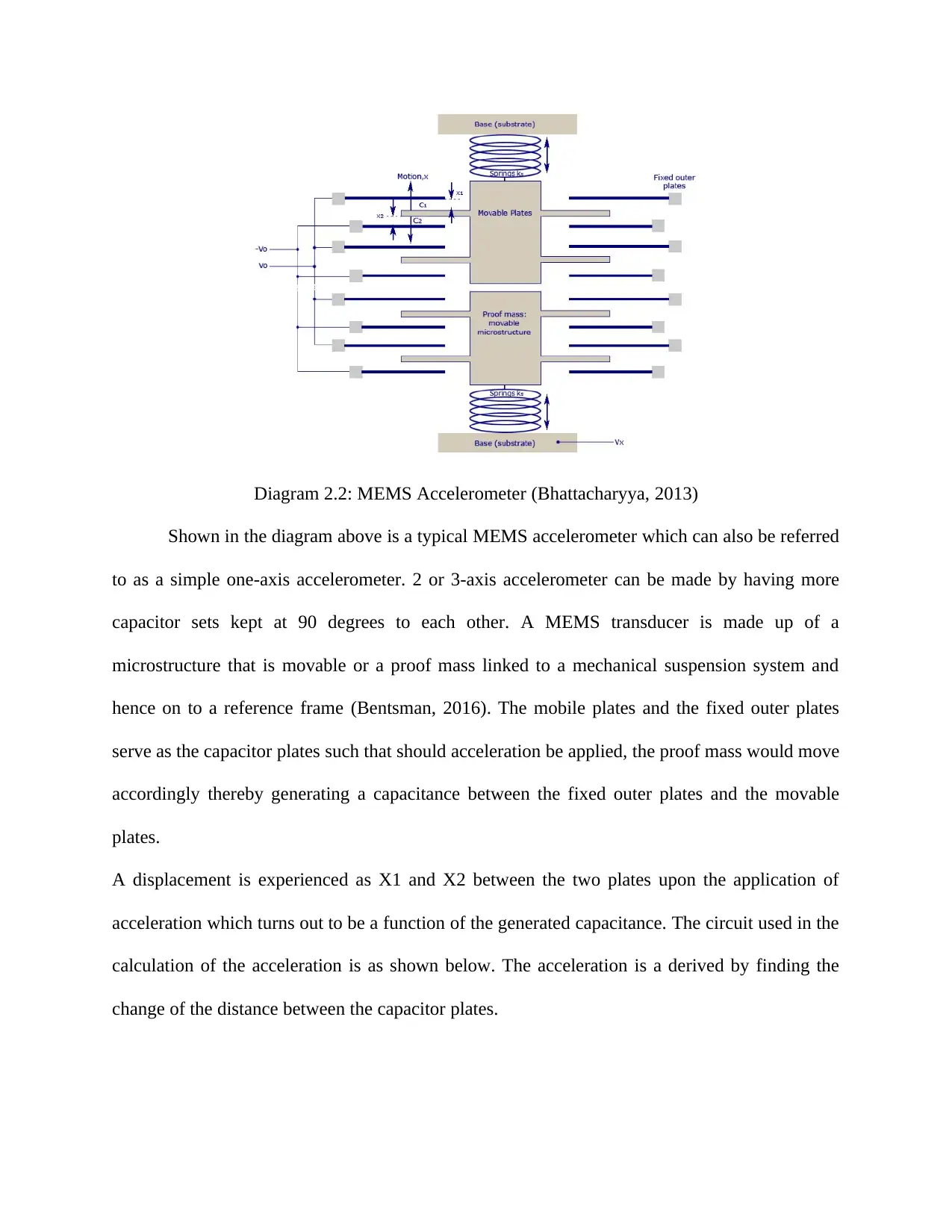
Diagram 2.2: MEMS Accelerometer (Bhattacharyya, 2013)
Shown in the diagram above is a typical MEMS accelerometer which can also be referred
to as a simple one-axis accelerometer. 2 or 3-axis accelerometer can be made by having more
capacitor sets kept at 90 degrees to each other. A MEMS transducer is made up of a
microstructure that is movable or a proof mass linked to a mechanical suspension system and
hence on to a reference frame (Bentsman, 2016). The mobile plates and the fixed outer plates
serve as the capacitor plates such that should acceleration be applied, the proof mass would move
accordingly thereby generating a capacitance between the fixed outer plates and the movable
plates.
A displacement is experienced as X1 and X2 between the two plates upon the application of
acceleration which turns out to be a function of the generated capacitance. The circuit used in the
calculation of the acceleration is as shown below. The acceleration is a derived by finding the
change of the distance between the capacitor plates.
Shown in the diagram above is a typical MEMS accelerometer which can also be referred
to as a simple one-axis accelerometer. 2 or 3-axis accelerometer can be made by having more
capacitor sets kept at 90 degrees to each other. A MEMS transducer is made up of a
microstructure that is movable or a proof mass linked to a mechanical suspension system and
hence on to a reference frame (Bentsman, 2016). The mobile plates and the fixed outer plates
serve as the capacitor plates such that should acceleration be applied, the proof mass would move
accordingly thereby generating a capacitance between the fixed outer plates and the movable
plates.
A displacement is experienced as X1 and X2 between the two plates upon the application of
acceleration which turns out to be a function of the generated capacitance. The circuit used in the
calculation of the acceleration is as shown below. The acceleration is a derived by finding the
change of the distance between the capacitor plates.
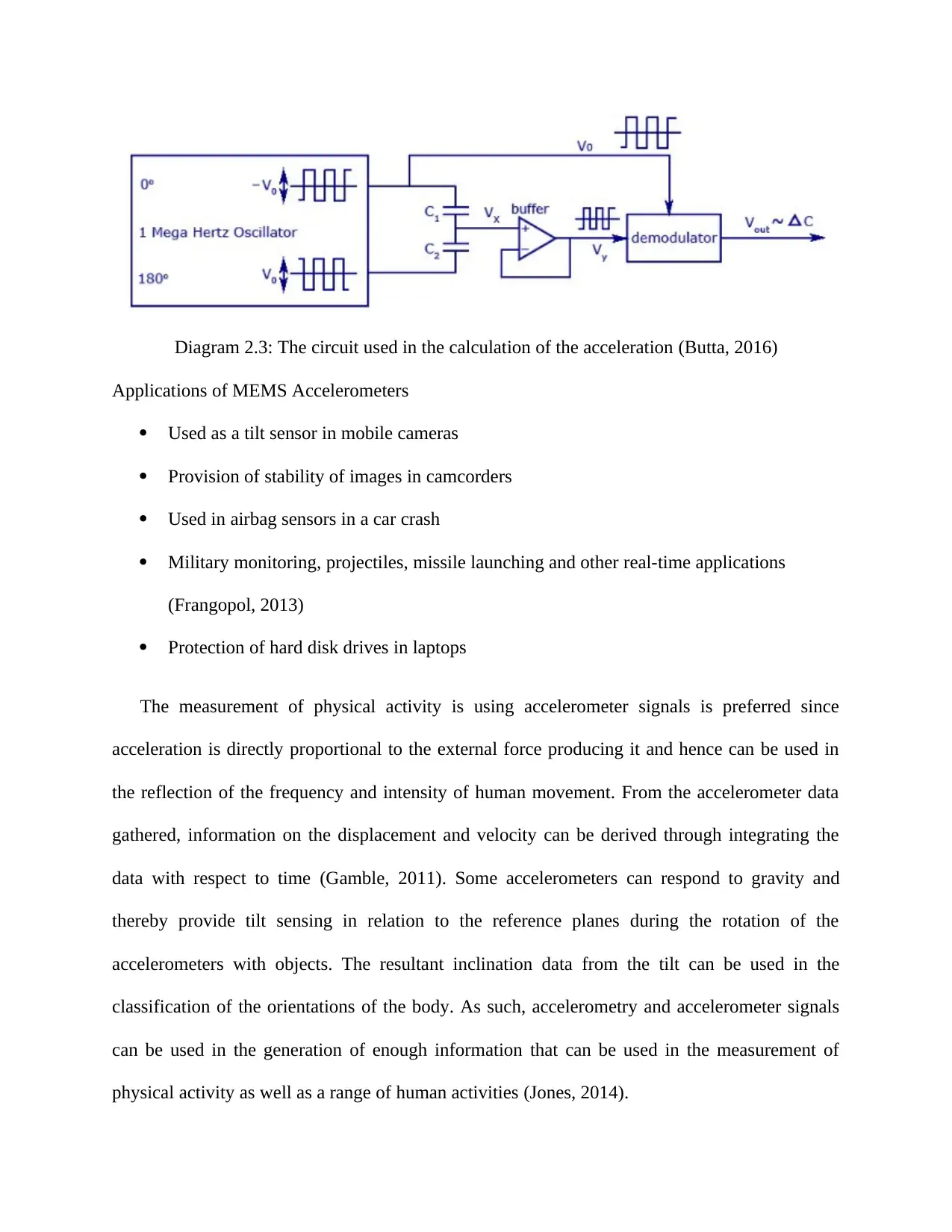
Diagram 2.3: The circuit used in the calculation of the acceleration (Butta, 2016)
Applications of MEMS Accelerometers
Used as a tilt sensor in mobile cameras
Provision of stability of images in camcorders
Used in airbag sensors in a car crash
Military monitoring, projectiles, missile launching and other real-time applications
(Frangopol, 2013)
Protection of hard disk drives in laptops
The measurement of physical activity is using accelerometer signals is preferred since
acceleration is directly proportional to the external force producing it and hence can be used in
the reflection of the frequency and intensity of human movement. From the accelerometer data
gathered, information on the displacement and velocity can be derived through integrating the
data with respect to time (Gamble, 2011). Some accelerometers can respond to gravity and
thereby provide tilt sensing in relation to the reference planes during the rotation of the
accelerometers with objects. The resultant inclination data from the tilt can be used in the
classification of the orientations of the body. As such, accelerometry and accelerometer signals
can be used in the generation of enough information that can be used in the measurement of
physical activity as well as a range of human activities (Jones, 2014).
Applications of MEMS Accelerometers
Used as a tilt sensor in mobile cameras
Provision of stability of images in camcorders
Used in airbag sensors in a car crash
Military monitoring, projectiles, missile launching and other real-time applications
(Frangopol, 2013)
Protection of hard disk drives in laptops
The measurement of physical activity is using accelerometer signals is preferred since
acceleration is directly proportional to the external force producing it and hence can be used in
the reflection of the frequency and intensity of human movement. From the accelerometer data
gathered, information on the displacement and velocity can be derived through integrating the
data with respect to time (Gamble, 2011). Some accelerometers can respond to gravity and
thereby provide tilt sensing in relation to the reference planes during the rotation of the
accelerometers with objects. The resultant inclination data from the tilt can be used in the
classification of the orientations of the body. As such, accelerometry and accelerometer signals
can be used in the generation of enough information that can be used in the measurement of
physical activity as well as a range of human activities (Jones, 2014).
⊘ This is a preview!⊘
Do you want full access?
Subscribe today to unlock all pages.

Trusted by 1+ million students worldwide
1 out of 40
Related Documents
Your All-in-One AI-Powered Toolkit for Academic Success.
+13062052269
info@desklib.com
Available 24*7 on WhatsApp / Email
![[object Object]](/_next/static/media/star-bottom.7253800d.svg)
Unlock your academic potential
Copyright © 2020–2025 A2Z Services. All Rights Reserved. Developed and managed by ZUCOL.




